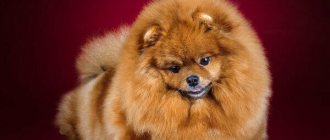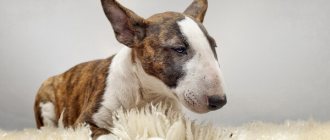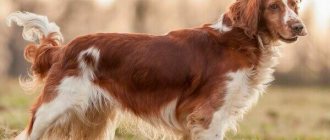Pomeranians are decorative dogs that have recently become increasingly popular due to their attractive exterior.
But it is very important that the pet is liked not only in appearance, but also in temperament, activity level and character traits.
Therefore, before purchasing a pet, you should find out more about it, read reviews from other owners - this will help you make the right decision.
Breed traits
Breed traits (on a 5-point scale)
| Pomeranian Spitz | |||
| Activity | in the house | 3.4 | |
| on the street | 3.4 | ||
| Obedience | training | 3.6 | |
| strangers | 3.6 | ||
| Domination | in family | 1.4 | |
| over dogs | 2.5 | ||
| Defending your territory | from people | 2 | |
| from dogs | 2.8 | ||
| Sociability | in family | 4.6 | |
| with strangers | 3.9 | ||
| with dogs | 3.6 | ||
| Concentration | in family | 1.6 | |
| in front of strangers | 1.9 | ||
| with dogs | 1.9 | ||
| Aggressiveness | in family | 1.5 | |
| to strangers | 1.8 | ||
| to the dogs | 2.1 | ||
| to cats | 2.3 | ||
| Family behavior | calmness | 4.2 | |
| demand for affection | 4.3 | ||
| excitability | 4.1 | ||
| playfulness | 4.1 | ||
| excessive barking | 3.5 | ||
| behavioral breakdowns | 1.9 | ||
| Tolerance for children | up to 4 years | 3.1 | |
| over 4 years old | 3.8 | ||
| Institutional use | watchman | 4.3 | |
| bodyguard | 1.7 | ||
This breed is often compared to the following dog breeds: Chihuahua, Pug, Maltese (Maltese Bichon), Papillon, Bichon Frize.
Pomeranian Spitz
Pomeranian Spitz
Reviews
Oleg: “My friends asked me to sit with a Spitz for 10 days. I took my dog with me to the dacha, she was next to me all the time, affectionate and kind. She refused to eat dry food and only liked boiled chicken. Her owners trained her to do important things in a litter box and didn't take her out often, so she was afraid to go outside. The most significant drawback is the hair, which is everywhere, the dog shed for 2 months in a row.”
Victoria: “My dog prefers only one owner and ignores other people. On the street she is aggressive towards all dogs, so we walk her separately. There’s a lot of wool at home, but no matter what, we all love it.”
Julia: “Our dog is almost 6 years old. She annoys her husband because of her loud barking. When she behaves quietly, she simply has no value, but every time the doorbell rings, a frantic howl begins. Without training, the animal will become impudent. And yet, different diets cause him stomach problems, so you need to choose one thing, either food or regular food.”
General characteristics of the Spitz breed
The Pomeranian Spitz is a devoted companion that easily finds a common language with any owner. A faithful friend for an adult, an active playmate for children. This dog is easy to distinguish from others: a sharp, seemingly smiling face, cheerful, inquisitive eyes, a fluffy fur coat, and a ringing bark. The best pet to keep in an apartment. In size and habits it resembles a cat, and in appearance it resembles a fox or a bear.
Descended from ancient wolf breeds, it is a subspecies of the dwarf German Spitz. This dog is hardy, active, and is used as a companion and watchdog. Gets along well with other pets and loves children. The Pomeranian is suitable for active people, as it needs long walks. He is capable of becoming a family favorite, and his funny appearance attracts the attention of others.
| Options | Characteristic |
| country of origin | Germany |
| purpose of the breed | decorative, companion |
| height | 18-24 cm |
| weight | 1.5-3.5 kg |
| life expectancy | 14-16 years old |
| aggressiveness | not aggressive, friendly |
| activity | average |
| intelligence | standard |
| training | uncomplicated |
| attitude towards loneliness | can't stand it |
| need for care | average |
| security qualities | average |
Pros of the breed
The Pomeranian Spitz is a popular dog, suitable for keeping in an apartment, for families with children. These pets have many advantages:
- cute appearance of a funny bear;
- cheerful, cheerful character;
- they are sociable, playful, ready to support any fun;
- loyal, adapt to the owner’s mood, love all family members;
- fearless, bravely protect their owners from any threats;
- easy to train, able to learn any commands, learn any tricks;
- clean, lick themselves, don’t smell like dogs;
- unpretentious, easily get along in any conditions;
- unobtrusive, adapt to the lifestyle of their owners;
- thick wool protects the dog from cold and heat;
- due to its small size, it can be kept in a small apartment;
- suitable for inexperienced owners, single people, families with children;
- Bear-type Pomeranians have good health.
Minuses
Despite their slightly doll-like cute appearance, these dogs are not for everyone. The disadvantages of the breed often include difficulties in maintaining and raising the Pomeranian. They also have other disadvantages:
- these little bears are quickly excitable, emotional and impulsive;
- often get into fights with other dogs;
- they love to bark, have a very loud voice, and are difficult to calm down;
- may show aggression towards strangers;
- Sheds a lot and is difficult to care for;
- tend to dominate, so strict education is required;
- They are very active, energetic; without sufficient physical activity, interior items and belongings may be damaged.
An interesting video will tell you about the advantages and disadvantages of dogs of this breed:
Tips for owners
For those who are just planning and who are already lucky enough to become the owner of a Pomeranian, it is important to familiarize yourself with the following tips:
- Be tough. Eccentric cunning people will definitely start twisting ropes out of their owners if they don’t understand in time who is in charge. Their trust can be earned through authority.
- Never lay your hand on an animal. Rigidity and cruelty are different things. If the prankster needs punishment, then simply ignoring him will make the Spitz rethink his behavior.
- Teach your pet the rules of behavior. Can't cope? Give it to the dog handler. A calm dog will please not only the owner, but also his neighbors.
- Don't get a dog if you have small children. This is especially true for owners of mini Pomeranians. This little one is a smaller copy of the original orange. It’s easy to injure such an animal.
Remember that care and love for a furry animal is the main thing that is required of you. You will have to devote a lot of time to hygiene procedures, but a beautiful pet is a real delight for the owner’s eyes.
Before purchasing a pet, carefully consider all the advantages and disadvantages. If the disadvantages outweigh the existing advantages, and you still want a decorative dog with long hair, then consider alternatives. Perhaps a good option would be the Yorkshire Terrier, an equally popular miniature breed.
Did you like the article? Tell your friends, leave a comment)
History of the origin of the breed
The Pomeranian is the smallest Spitz. This breed has been known since ancient times. In Europe, back in the Stone Age, there lived turf dogs, similar to modern Spitz dogs. They were large, strong, unpretentious. In the Middle Ages, these dogs were used as mounts and guards. In the 18th century, one of the small Spitz dogs came to Great Britain to Queen Charlotte. She liked the dog and became popular among the nobility.
At first these dogs were larger, weighing about 9 kg. But dog breeders tried to breed dwarf representatives of the breed. In the 19th century, selection began, the smallest individuals were selected. They had a flattened muzzle and fluffy fur. Back then these dogs were called miniature Spitz dogs. At the end of the 19th century, the new breed was officially recognized. Since such dogs were first brought from the German province of Pomerania, they were called Pomeranian Spitz.
The fashion for such miniature dogs has spread throughout Europe. They were bred by noble ladies as indoor decorative pets. White Pomeranians, the larger representatives of the breed, were popular back then. At the beginning of the 20th century, Spitz came to the United States. Amateur clubs appeared, and a breed standard was adopted.
Due to World War II, the breed almost disappeared. Its revival began in the 90s of the 20th century. An updated standard was adopted, according to which the dog should weigh 2-3 kg, height 18-22 cm. Mini varieties are not recognized by the standard, since they cannot participate in breeding.
"Galatiness"
Pomeranians are very sociable, so the barking will not stop all day long. For an animal, this is the main way of expressing its feelings and spiritual breadth. In modern high-rise buildings with their thin walls without sound insulation, the sonorous voice of the orange can be heard throughout all floors.
Easily excitable and too impulsive, little “bears” have difficulty responding to calm. It is important to train your Spitz correctly in order to correct this point.
Appearance of Spitz dogs
Pomeranian Spitz belong to the breeds of the primitive type, part of the European Spitz section. According to standards, the height at the withers is equal to the body length and is 18-22 cm. Weight is up to 3.2 kg. Exhibition representatives of the breed weigh 2 kg. Mini Spitz have a weight of 1.5-2 kg and a height of up to 18 cm.
Head
The head is medium in size, round, wedge-shaped. The forehead is rounded, the stop is clearly defined, the cheekbones are not visible. The muzzle is narrow and short. Scissor bite, cheekbones not prominent. The chin is slightly raised and the lips are pressed tightly together. The nose is small, upturned, black, but in red individuals it can be brown.
The eyes are round, small, and located close to each other. The eyelids are black, the look is cheerful, intelligent. The ears are triangular, pointed, small, set close and high.
Body type
The physique is muscular, dense, square in shape. But the dog carries himself with grace and grace. The neck is strong, slightly arched, covered with hair, which forms a luxurious collar. No suspension is formed. The chest is deep, the stomach is tucked. The back and croup are short. The tail is of medium length, set high. He bends into a ring and lies on his back.
Limbs
The limbs are straight and parallel. The front ones are set wide apart and muscular. The hind legs are densely covered with hair. The paws are small, round, gathered into a ball. The pads are hard. The dog moves elastically, freely, springily.
The photo shows what a Pomeranian Spitz looks like according to the standard:
Appearance of a Pomeranian Spitz
Pomeranian Spitz - appearance
Coat and color
The coat is long, with a thick soft undercoat. On the legs, head, ears it is quite short and protruding. On the body it is straight, 5-6 cm long. On the neck and shoulders there is a thick collar resembling a mane. The hind legs have fluffy pants, the tail is well furred. Such a thick coat is only formed in adult Pomeranians by the age of 3 years.
The standard allows several colors. Often puppies born with the same coat color change it as adults. The final color is established after the guard hair grows.
- The most popular are orange or golden-red Spitz. They resemble little foxes. The intensity of color on different parts of the body may be heterogeneous.
- Black Pomeranians are common. Their coat is varnish-shiny, without inclusions of other colors.
- The chocolate color should be rich and dark. These dogs' noses, lips and eyelids may also be brown.
- The white color of Pomeranians should be uniform, without spots of a different color.
- Wolf or gray-sable. The silvery fur is black at the tips. The head is darker than the body.
Less common are cream, black and tan, and sable. The standard allows the presence of spots located symmetrically. For such dogs, the main color should be white. The pure black and brown Spitz looks like a bear cub. Blue, chocolate and tan, brindle colors are not recognized by the standard.
It has been noticed that the color of the orange's fur determines its quality. Cream-colored individuals have the fluffiest and softest fur. Red ones have less hair, while black ones have coarser hair.
Varieties
There are several varieties of Pomeranian Spitz. The differences between them are little noticeable. The phenotype depends on heredity and may appear over a generation. It is finally formed after a year.
- Standard Pomeranian with a fox face. He has round eyes and a small nose.
- The bear-type Pomeranian is more popular. Its muzzle is shorter, its head is round, and its lower jaw is wide. This bear differs from others in having an upturned nose, a lot of fur on its cheeks, and small ears.
- Puppet type with an almost flat muzzle. The forehead is wide, the eyes are deep-set.
The differences between the different types are only in the shape of the muzzle. The rest of their breed characteristics are the same. There is also a mini variety, 16-18 cm tall, weight 1.5-2 kg.
Photos of different colors and types of representatives of the breed show the differences between them:
Fox Nose Pomeranian
Bear-type Pomeranian
Pomeranian doll type
Disqualifying faults
If Spitz dogs exhibit deviations from the standard, they are not allowed to breed and show. Some of them are noticeable only in adult dogs. There may be the following disadvantages:
- snack or undershot;
- white spots with dark color;
- strongly convex or flat skull;
- very sharp muzzle or sharp stop;
- light eyes or nose;
- bulging eyes, everted eyelids;
- semi-erect ears;
- deviations from height and weight standards.
Interesting Facts
The ancestors of the small fluffy Spitz dogs were northern sled dogs, which were bred in the Icelandic snowy expanses.
Many famous people choose to have an Pomeranian as a pet. Connoisseurs of this breed include the Osborne family, Sylvester Stallone, Elvis Presley, Paris Hilton, Maria Sharapova.
In some European countries, miniature Spitz dogs serve as caregivers for seriously ill people, due to their sensitive nature and intellectual development.
The Pomeranian came to England from Italy along with Queen Victoria, who had 6 such dogs, one of them, Marco’s favorite, was buried with Her Majesty.
The initial weight of the dogs was 15-16 kg.
Character of Pomeranian Spitz
The Pomeranian is a devoted friend and brave protector. From his ancestors - German Spitz - he inherited courage, endurance, and energy. These dogs are curious, always on the move and exploring the world around them. They need the opportunity to run around and burn off energy, so walks should be active, with active games.
The Pomeranian becomes very attached to its owner and senses his mood. If they don't pay attention to him, he will be sad. The dog is ready to accompany the owner everywhere, support him in any games, amuse him and express his joy with a ringing bark. She can attract the owner's attention in different ways. This pet loves all family members, but becomes attached to only one, and is very sad in his absence.
Pomeranians are characterized by the following qualities:
- activity;
- good nature;
- devotion;
- curiosity;
- sociability;
- agreeableness;
- cleanliness;
- intelligence;
- cockiness;
- restlessness.
The Pomeranian Spitz is wary of strangers. Although he does not show aggression, he does not allow himself to be touched. And if threatened, it can attack and bite. Gets along well with children and pets if he grew up with them. Due to the hunting instinct, it is undesirable to keep Pomeranians in the same house with birds and rodents
Education and training
Pomeranians are very intelligent for a toy breed. Their intelligence and intelligence were inherited from their ancestors who served man. And now these little dogs can work in the police or rescue service, guard the house or clear the area of rats.
They are able to learn any commands and skills. But they are best at those that require a lot of movement. The commands “fetch” and “fetch” are especially easy to learn; they can learn agility, freestyle, and frisbee.
You need to start training your pet as early as possible. Spitz dogs strive for dominance and can be stubborn, so you need to immediately show your pet who’s boss. In the first six months of life, the dog must learn the rules of behavior in the house and on the street, understand the commands “no”, “come to me”, “place”, “sit”, “stand”, “near”, “fu”. It is important to teach your Pomeranian not to bark constantly, especially if he lives in an apartment building.
Education should be consistent, persistent, but gentle. Physical punishment should not be used; in response to such an attitude, he may become capricious and aggressive. It is better to interest the Pomeranian and reward him for correct behavior with affection or a treat.
List of nicknames
When choosing a name for a Spitz boy or girl, you should remember that this is a dog of aristocratic origin, and it is better to exclude offensive nicknames. Be that as it may, the owner will still affectionately call his shaggy treasure and the noble nicknames will turn into Musya, Pupsik and Bubochka.
Dog breeders advise calling the dog a short name, not exceeding two syllables, so that it is easier for the animal to remember its name, and the owner can quickly pronounce the name during a walk.
The following nicknames are suitable for boys:
- Rocky, Casper, Elvis, Raisin, Dymchik, Verdi;
- Umka, Bublik, Zhik, Danko, Zeus, Lord and others.
For girls, more feminine names are suitable, for example:
- Lucky, Rippy, Vega, Daffney, Elka, Zizi, Kiwi;
- Spark, Roxy, Chelsea, Lexi, Zhani and others.
Maintenance and care
The Pomeranian Spitz is a fairly unpretentious pet that adapts to any living conditions. Thanks to its thick coat, it does not freeze in winter and easily tolerates summer heat. But due to the short muzzle, heat exchange in these dogs is poor. Therefore, you cannot keep them outside; the Pomeranian is an indoor pet. You can toilet train at home using a diaper. But you still need to take him outside to run for at least an hour a day.
Apart from grooming, other hygiene procedures are the same as for other dogs:
- brush your teeth once a week and give chewing bones;
- check and wipe your eyes and ears daily;
- Trim nails monthly.
Grooming
The thick, long coat of Pomeranians needs to be brushed well every few days. This will prevent the formation of tangles. To remove dead hairs, the comb movements should be directed against the hair.
You should not often bathe your Pomeranian. His skin is prone to dryness and allergies. It is recommended to completely wash it only if it is heavily soiled, or after shedding. Be sure to use a special shampoo and conditioner. After a walk, you can wash your paws and belly, and if necessary, wipe the fur with a damp towel.
Many owners give their pets haircuts. When the fur is short, it is easier to care for, and the fluffy bear turns into a fun plush toy. But experts do not recommend cutting these dogs short. Because of this, the structure of the coat may be disrupted, it begins to fall out, and the guard hair disappears.
It is better to entrust a dog that participates in exhibitions to a groomer. He will do the right haircut, trimming the ends, and remove hair from the ears, butt, and paws. It is recommended to bathe your pet before the exhibition.
The photo shows how oranges change after a haircut:
Pomeranian Spitz after haircut
Puppet type. Spitz after haircut
Pomeranian Spitz before and after haircut. Teddy Bear
Feeding
Pomeranians are dogs that love to eat and are prone to gaining excess weight. Therefore, it is better to choose dry food intended for this breed. It contains all essential nutrients balanced. Super premium food for small breeds is also suitable. Do not exceed the dosage recommended on the packaging. Usually this is about 100 g at a time.
If you feed your Spitz natural food, you need to give him the following foods:
- boiled lean meat at least 30% of the diet;
- porridge – buckwheat, rice – up to 10%;
- dairy products;
- sea fish, eggs – once a week;
- boiled vegetables.
With this feeding, additional vitamin supplements must be given. Fatty meats, river fish, smoked meats, potatoes, legumes, onions, baked goods, and sweets are contraindicated. Pomeranians require 200-250 g of food per day, so this type of food is inexpensive.
Health
If you feed your orange correctly and provide it with sufficient exercise, health problems will not arise. These dogs are long-lived, they can live 16-18 years. You only need to give an anthelmintic every 3 months, regularly treat against parasites in the warm season and do all the necessary vaccinations.
This is a strong, hardy and efficient dog. Sometimes the following health problems occur:
- dental problems;
- eye pathologies, lacrimation;
- pathologies of the skeletal system, joint dislocations;
- diseases of the digestive tract;
- hypothyroidism
Bear type dogs have a fast metabolism. They get sick more often; if you feel unwell, you should immediately contact a veterinarian. Mini varieties are not recommended for breeding. They are weak and painful.
Nutrition
A properly formulated diet for a Pomeranian is an important part of caring for your pet. If the food is of poor quality and unbalanced, this will affect its activity and coat. The coat will lose its shine, constant shedding will begin, and the dog will feel tired.
Expert opinion
Anna Abramenko
An avid dog lover. Experience in veterinary medicine since 2009.
Ask a Question
From puppyhood, the dog should be accustomed to regular foods, with dry food as a supplement. If a dog is accustomed to this diet from childhood, it will begin to refuse normal food.
When bringing a puppy from another owner, where he spent the first months of his life, you should also obtain information about what the dog was fed. It takes time to switch from one diet to another, from 7 to 10 days. You need to change products gradually.
The orange diet should contain:
- raw and cooked meat;
- dairy products;
- cottage cheese;
- stewed vegetables with vegetable oil;
- eggs;
- dried fruits.
It is necessary to monitor the weight of a small dog, since breeds with short legs will have difficulty moving when their body weight begins to exceed the norm. Fat dogs become lazy and lose activity.
Foods that are unhealthy for a Spitz and cause problems with weight and health are the following:
- whole milk;
- fatty pork;
- fried and smoked foods;
- sweet products;
- sausage;
- salty food;
- cold and hot dishes.
Useful article: What to feed your Spitz: 10 best premium dry food for Pomeranian and German Spitz
How to buy a puppy
It is difficult to determine from Pomeranian puppies what they will be like when they grow up. Breed characteristics such as a fox or bear face or color appear only by 4 months. Although coat color may change after shedding, it is recommended to buy a puppy after 4 months.
To do this, you need to choose a good nursery or a responsible breeder. Due to the popularity of the mini varieties, these dogs are sometimes bred without paying attention to health and compliance with the standard.
A purebred Pomeranian cannot be cheap. In Moscow, the price of a puppy starts from 30 thousand rubles. If a Pomeranian is offered inexpensively, you need to be wary: either he is undocumented or has developmental defects. Without a pedigree, such a dog can be bought for 15-30 thousand. You just need to study the reputation of the breeder and the living conditions of the animals.
When choosing a pet, it is recommended to watch the babies, pick them up and examine them. A healthy puppy should have:
- black wet nose;
- clean eyes and ears without an unpleasant odor;
- thick soft wool without dandruff and bald spots;
- the paws are straight, the belly is not bloated, the back does not sag;
- lively, playful mood;
- lack of aggression or cowardice.
You should not pay attention to the size and color; they can change with age. It is imperative that a puppy, even one without a pedigree, must have a veterinary passport and all vaccinations appropriate for its age.
The photographs show what Spitz puppies should look like:
Pomeranian puppy
Pomeranian puppies
Puppies
Another interesting video will help you form a final impression about these dogs:
The Pomeranian is an amazing dog with an unusual appearance and luxurious coat. But this pet is not suitable for everyone. It is not advisable to get one for those who do not have time to walk the dog, play with it, or pay attention to it. But this cheerful, cute dog is able to brighten up loneliness and keep a child or an elderly person company. He will become a devoted friend and vigilant protector.
Weaknesses of bitter orange
Owners of Pomeranian Spitz note several possible problems that can hardly be called defects of the breed. These are, rather, inconveniences caused by the characteristics of a fluffy dog:
- Wool "all over the area." If you comb your dog on time and thoroughly, there will be no special problems with cleaning. The dog actively sheds only during the season (spring). During this period, the pet will have to be combed daily.
- Teeth. The period of changing teeth is difficult for both the owner and the dog. Baby teeth often have long roots and refuse to fall out and give way to permanent ones. As a result, an incorrect bite is formed. If this happens, you will have to contact a veterinarian.
- Barking. Pomeranians are very talkative. They bark with or without reason simply from the generosity of their souls. But with proper training, this deficiency is eliminated quite quickly.
- The desire to dominate. This character trait needs to be eradicated from day one. You cannot allow the puppy to feel like the “leader of the pack” even for a minute.
A well-bred and timely vaccinated dog usually does not cause problems, but the owners will have to go through a difficult stage of upbringing and “grinding in” their characters. As soon as the baby recognizes the person as the main one, he will become an affectionate, obedient and cheerful companion.
Who is this dog suitable for?
Spitz is an ideal dog for lonely elderly people.
First of all, such a dog is suitable for people who are well familiar with the description of the breed and the character of Spitz. Single elderly people can get such a small dog. She will become a true, loyal friend for them, who will never give in. Also, a Spitz is an ideal choice for people who have never had pets in the house before. The fact is that even inexperienced dog breeders can handle his training and education.
Spitz are unique dogs that cannot be confused with any other breed. Many people dream of having such a pet so that they can enjoy its unusual appearance at any time. However, before this, you need to familiarize yourself with the characteristics of the Spitz breed and the rules of care.











